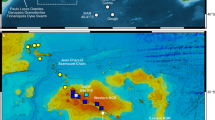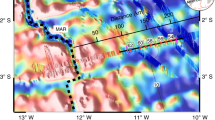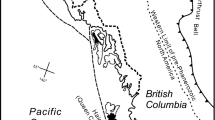Abstract
ACCORDING to the ideas of Hess1 the backbone of active mid-oceanic ridges should consist of peridotites which originated in the Earth's mantle and were subsequently upthrusted into the crust along the axis of ridges, above the up welling limbs of mantle's thermal convection cells. The ultramafics should lie below a layer of basalt about 1 km thick, generated by partial melting of the upwelling mantle material.
This is a preview of subscription content, access via your institution
Access options
Subscribe to this journal
Receive 51 print issues and online access
$199.00 per year
only $3.90 per issue
Buy this article
- Purchase on Springer Link
- Instant access to full article PDF
Prices may be subject to local taxes which are calculated during checkout
Similar content being viewed by others
References
Hess, H. H., in Petrologic Studies: A Volume in Honor of A. F. Buddington, 260 (Geological Society of America, New York, 1962).
Heezen, B. C., Bunce, E. T., Hersey, J. B., and Tharp, M., Deep Sea Res., 11, 11 (1964).
Author information
Authors and Affiliations
Rights and permissions
About this article
Cite this article
BONATTI, E. Ultramafic Rocks from the Mid-Atlantic Ridge. Nature 219, 363–364 (1968). https://doi.org/10.1038/219363a0
Received:
Published:
Issue Date:
DOI: https://doi.org/10.1038/219363a0
This article is cited by
-
Coupled major and trace elements as indicators of the extent of melting in mid-ocean-ridge peridotites
Nature (2001)
-
Low-calcium garnet harzburgites from southern Africa: their relations to craton structure and diamond crystallization
Contributions to Mineralogy and Petrology (1993)
-
Active in situ disaggregation of oceanic crust and mantle on Gorringe Bank: analogy with ophiolitic massives
Nature (1982)
-
A petrographie study of the process of serpentinisation in ophiolites and the ocean crust
Contributions to Mineralogy and Petrology (1979)
-
Petrology of rodingites from the equatorial Mid-Atlantic fracture zones and their geotectonic significance
Contributions to Mineralogy and Petrology (1975)
Comments
By submitting a comment you agree to abide by our Terms and Community Guidelines. If you find something abusive or that does not comply with our terms or guidelines please flag it as inappropriate.



